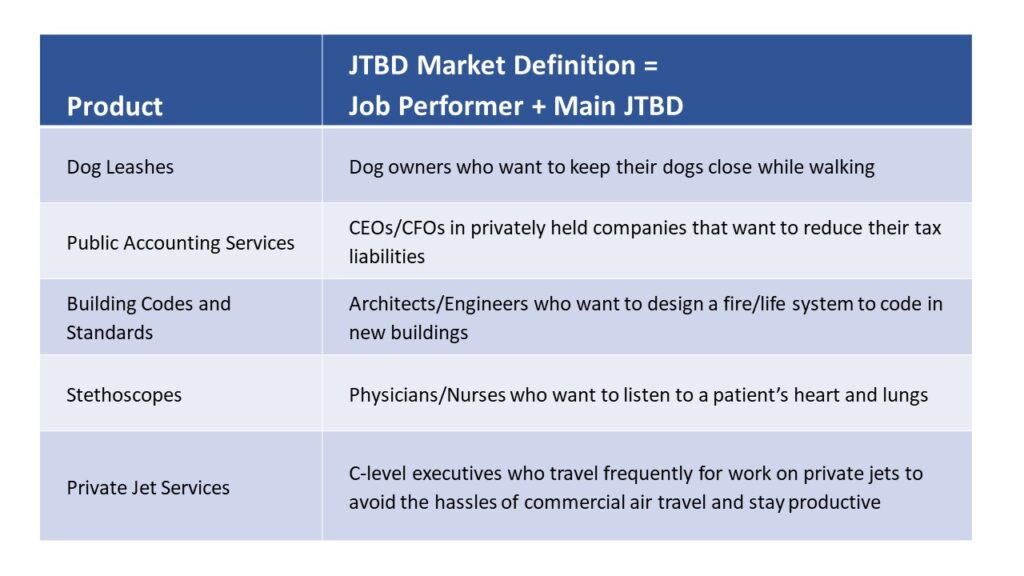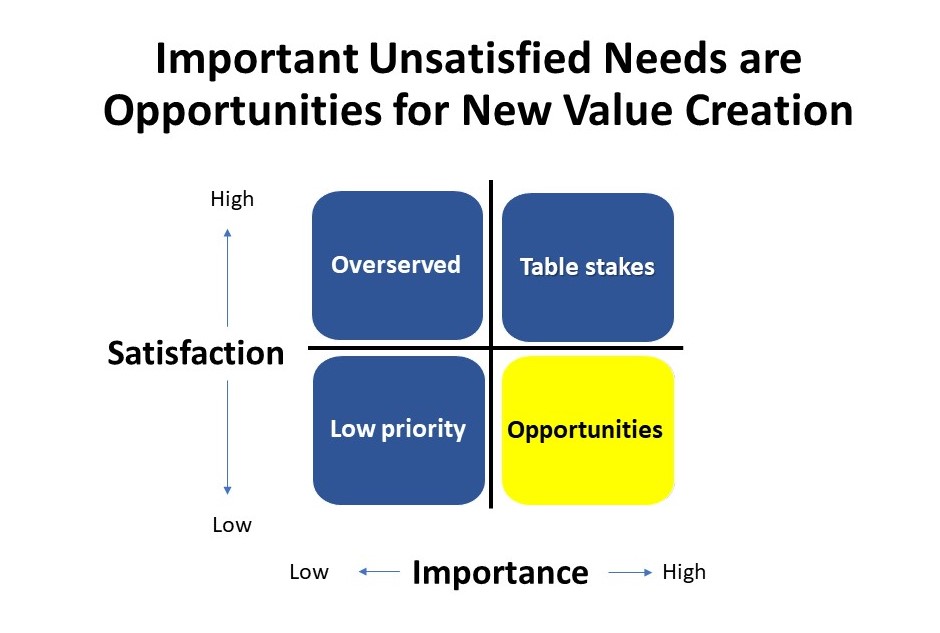How to Differentiate and Grow with the JTBD Innovation Map (Part 1)
In my last article, How Jobs-to-Be-Done Changes the Game of Innovation and Growth Strategy, I briefly explained Jobs theory and provided what I have found to be the most useful definition for innovation. Today I would to illustrate you can differentiate and grow in a repeatable manner with the Jobs-to-Be-Done (JTBD) Innovation Map based on the same definition of innovation that I introduced last time:
“Innovation is the process of discovering the target customers’ unmet needs and then developing solutions to address them.”
This definition is helpful because it separates the two very different steps of innovation. The only way doctors can deliver consistently good patient outcomes is to accurately diagnose the patient’s condition and then develop the treatment plan.
Similarly, the only way innovators can deliver consistently good customer outcomes is to accurately diagnose their customers’ condition – i.e., identify the customer’s unmet needs – and then develop solutions to address them. Sequencing matters.
Most people, even many veteran innovators, firmly believe that innovation is inherently risky and messy, and nothing can change that. But that’s because most businesses don’t effectively discover their target customers’ unmet needs before generating solution ideas. Innovation WILL ALWAYS be risky and messy until organizations learn how to discover their target customers’ unmet needs before generating solution ideas. JTBD enables firms to nail the customer diagnosis and thereby minimize the “market risk” of innovation, that is, the risk that people won’t buy your offering because it doesn’t address an important unsatisfied need.
The JTBD Innovation Map breaks these two high-level steps of innovation into three sub-steps (See Figure 1. Below). It builds on the pioneering work and classic Harvard Business Review article by Lance A. Bettencourt and Anthony W. Ulwick: The Customer-Centered Innovation Map. The authors introduced this job map to help companies deconstruct their target customer’s main functional job into the discrete steps they are trying to execute to get the job done. By identifying the steps customers are trying to execute, as well as where they struggle and why given their current product/service solution, suppliers can create unique value for customers by helping them execute each step seamlessly. The product or service that helps target customers get their jobs done best wins (all other things being equal).
Similarly, the JTBD Innovation Map is intended to help companies deconstruct their innovation team’s main job: to create unique value for target customers. The company that has the most reliable process to create unique value for target customers has a strong competitive advantage.
Figure 1.

Job maps are different from the better-known customer journey maps. A customer journey map documents the steps customers go through when locating, selecting, acquiring, and using a firm’s product or service. Job maps, on the other hand, identify the steps customers must go through to get a job done independent of any product or service solution. Documenting the steps with solution-free language enables firms to avoid being constrained by current solutions and reveal opportunities for innovation and growth that would otherwise go undetected.
Let’s briefly walk through the first three steps of the JTBD Innovation Map.(I’ll address the last three steps in my next issue).
3 Steps to Discover Unmet Needs
1. Define the Market.
Most of us have been taught to define markets according to an existing product category and the historical revenue that the products in that category have generated over the past year. For example, we might say that dog leashes are a $1B market if a million leashes were sold for an average of $10 per leash last year (100 million x $10 = $1B). While this can be very useful information for business planners and pet product brand managers, innovation leaders need to look into the future to determine what the demand will be for something that doesn’t even exist yet. Most people think that’s impossible, but it is not.
We can dramatically increase the likelihood of success of new offerings by redefining a market as “a group of people who want to get a specific job done1.” This non-financial, job-based, forward-looking definition of a market enables firms to determine the demand for a non-existent product/service in the future. Products come and go but the jobs people want to get done remain remarkably stable over time. Remember, people don’t want to buy a ¼” drill; they want a ¼” hole. Products and services only exist to help people get their preexisting jobs done. Market demand is the desire people have to get a job(s) done separate and distinct from products and services.
Further, markets can be sized before any product or service solution even exists as well. This is done by determining:
• How many people want to get the job done
• How frequently they want to execute the job
• How important the job is to get done
• How unsatisfied target customers are with current product/service solutions
• How much they’re willing to pay to get the job done perfectly. (For more detail, see To Be Innovative, You Must See into the Future and Sizing Markets for Offerings That Don’t Exist).
I know this goes against conventional wisdom. Many people insist that “great innovators create demand (or needs) that people didn’t even know they had.” This is a misbelief based on confusing customer needs with product solutions. While marketing and advertising can increase preexisting demand, I have yet to see a company actually “create” demand. Companies create offerings that satisfy preexisting demand. This is true for all new product innovations, even new-to-the-world innovations from Apple, Amazon, Tesla, and other exemplars. Product and service solutions only exist because, first, a customer wanted to get a job done, feel a certain way, or have an experience and needed help. (For more detail, see Forget About Trying to Create Customer Needs).
When you define your target market from a JTBD point of view independent of any product or service solutions, you’ll see that you don’t just compete with other products or services in your “category.” You compete with anyone or anything that target customers use or do to get their job done. For this reason, markets are often much larger than most leaders think. This opens the door to create disruptive innovation by identifying and removing the barriers that are keeping some people (who want to get the same job done) from purchasing current solutions.
Figure 2 below gives some examples of various product markets redefined from the customer’s point of view with JTBD.
Figure 2. Product vs. JTBD Market Definitions

According to strategy thought-leader Roger L. Martin, the two most important questions that must be answered to formulate a good strategy are, “Where will we play?” and “How will we win?” The question “Where will we play?” establishes what is in-bounds and what is out-of-bounds. This typically requires leaders to make decisions about what geographies, what customers, and what product categories to play in.
Redefining your markets from a JTBD point of view, however, brings a new level of insight and power to formulate winning strategy. The unit of analysis should be the main functional job(s) the target customer is trying to get done, not the customer themselves. That’s because, as the late Harvard Business School Professor Clayton Christensen said,
“With an understanding of the ‘job’ for which customers find themselves ‘hiring’ a product or service, companies can more accurately develop and market products well-tailored to what customers are already trying to do.”
2. Discover the Target Customers’ Needs
Misunderstanding the target customers’ needs is the number one reason for new product failure. This is largely due to wide-spread confusion about what a customer “need” really is. Innovation professionals talk about “exciters, delighters, benefits, requirements, specifications, wants,” etc., as if all of these types of information are equally important; they are not. The aforementioned Tony Ulwick changed our understanding of this with the insight that, for the purpose of innovation, customer “needs” are best defined as the functional, emotional, and social jobs people are trying to get done and the criteria (or desired outcomes) they use to measure success when executing the main functional job. These need statements rigorously avoid using any solution language.
Contrary to conventional wisdom, people can tell us what they want if we ask them what they want to accomplish rather than asking them for product or service specifications. (For more detail, see How JTBD Reveals Latent Unarticulated Needs).
Another way to think about this is with the Seven Habits of Highly Effective People in mind. If you’re familiar with Stephen R. Covey’s seven habits, you may remember that right after “Be proactive” (the 1st habit) is “Begin with the end in mind” (the 2nd habit). More recently, the Franklin Covey website added “Define clear measures of success and a plan to achieve them” to the 2nd habit as well. That’s exactly what JTBD is doing except that, for effective innovation, you must discover the target customers’ end-in-mind and measures of success, and give them a way to get the job done better than other options. (For more detail, see The Three Habits of Highly Effective Innovators).
3. Determine Which Needs are Unmet, i.e., Opportunities
Not all customer needs are unmet and therefore many are not opportunities for innovation and growth. Generally, only needs that are important and unsatisfied are opportunities. The more important and less satisfied a need is the greater the opportunity for innovation and growth it presents. (See Figure 3 below).
Figure 3.

Determining which needs are opportunities can be challenging with qualitative interviews alone. That’s because no quantitative ratings of the customer’s needs are obtained and because the sample size is usually too small to be statistically valid. Even so, qualitative interviews can deliver game-changing insights by revealing the target customers’ jobs to be done, criteria for success, and circumstances. This information will virtually always help a firm make progress on their strategy and innovation objectives.
In complex functional markets, however, developing and deploying a quantitative survey to identify and rank the opportunities in the market can be invaluable. To do this, we take all the customer needs discovered in the interviews, structure them into an unambiguous language format to ensure the customer ratings are valid, and then deploy them in a survey to a representative sample of target customers to be rated for importance and satisfaction. This enables firms to identify and rank the opportunities in their market with precision and statistical validity. Not surprisingly, this gives leaders great clarity and confidence about where to focus and what to do to create unique value for customers. Or, in Roger Martin’s terms, where to play and how to win. (More on that next time).
In some cases, companies may find a number of needs are over-served, that is, unimportant and highly satisfied (top left quadrant). Such needs may present an opportunity for the firm to remove functionality and complexity to reduce cost and thereby make a more attractive offering. The specificity of the need statements along with their quantitative ratings for importance and satisfaction makes JTBD very useful for guiding product feature tradeoffs.
Find Hidden Segments of Opportunity

Another significant benefit of deploying a quantitative survey is that it enables companies to conduct “jobs-based” segmentation. This finds hidden segments of opportunity, segments about which competitors are probably not aware.
While the common practice of targeting customers based on their demographics can be helpful when there is a strong correlation between the customers’ demographics and their purchasing behavior, “correlation does not explain causality.” For that reason, this approach often leads to new product failure. That’s because people don’t buy products/services because of their demographic attributes; they buy products/services to get their jobs done.
Analyzing the market to discover the opportunities at the total market level can be tremendously helpful because it minimizes the “market risk” of innovation (the risk of misunderstanding the customers’ needs). You can be confident that a large portion of the market considers that need important and unsatisfied. Looking only at the total market analysis, however, can obscure great opportunities within market segments. That’s because the total market ratings are derived with averages. It is not uncommon, for example, to find very limited opportunities at the total market level and abundant opportunities with a segment or two. This is true in most mature markets. It’s pretty exciting when you can uncover hidden opportunities in a market segment that the competitors didn’t know about, and design an offering uniquely suited for them.
Every market has people who have different opinions about which needs are important to get done and which are unsatisfied by their current product/service solution. These different opinions (and ratings) make it possible to identify the unique opportunities in each segment and size the segment. This is a breakthrough in segmentation theory and practice because, up until the advent of JTBD, most organizations segmented markets according to demographics, psycho-graphics, usage, etc.
Summary
Many leaders struggle with how to differentiate and grow because they don’t know which of their target customers’ needs remain unmet. Without JTBD, innovation often becomes a guessing game that leads to high failure rates, a lot of frustration, wasted time and resources, opportunity costs, and even reputation damage – all of which is unnecessary. Firms that know how to nail the “customer diagnosis” with JTBD can change the game, minimize their market risk, and dramatically improve their results.
The output from Step 3 above is a ranked list of the biggest opportunities in the market. With that list in hand, now the company is ready to execute Steps 4-6 to “Develop Solutions.” Let’s pick things up there next time!
This is my attempt to provide companies with a useful JTBD Innovation Map that you can use to bring more predictability to your innovation efforts. By simply applying jobs thinking and executing the process in the proper sequencing, firms can dramatically improve their results. Let me know if you find this helpful. I appreciate feedback, questions, and comments!
Footnote:
1. See What Customers Want, Using Outcome-Driven Innovation to Create Breakthrough Products and Services, by Anthony W. Ulwick. Tony is the chief pioneer of JTBD.
Copyright © 2022 Reveal Growth Consultants. All rights reserved.




